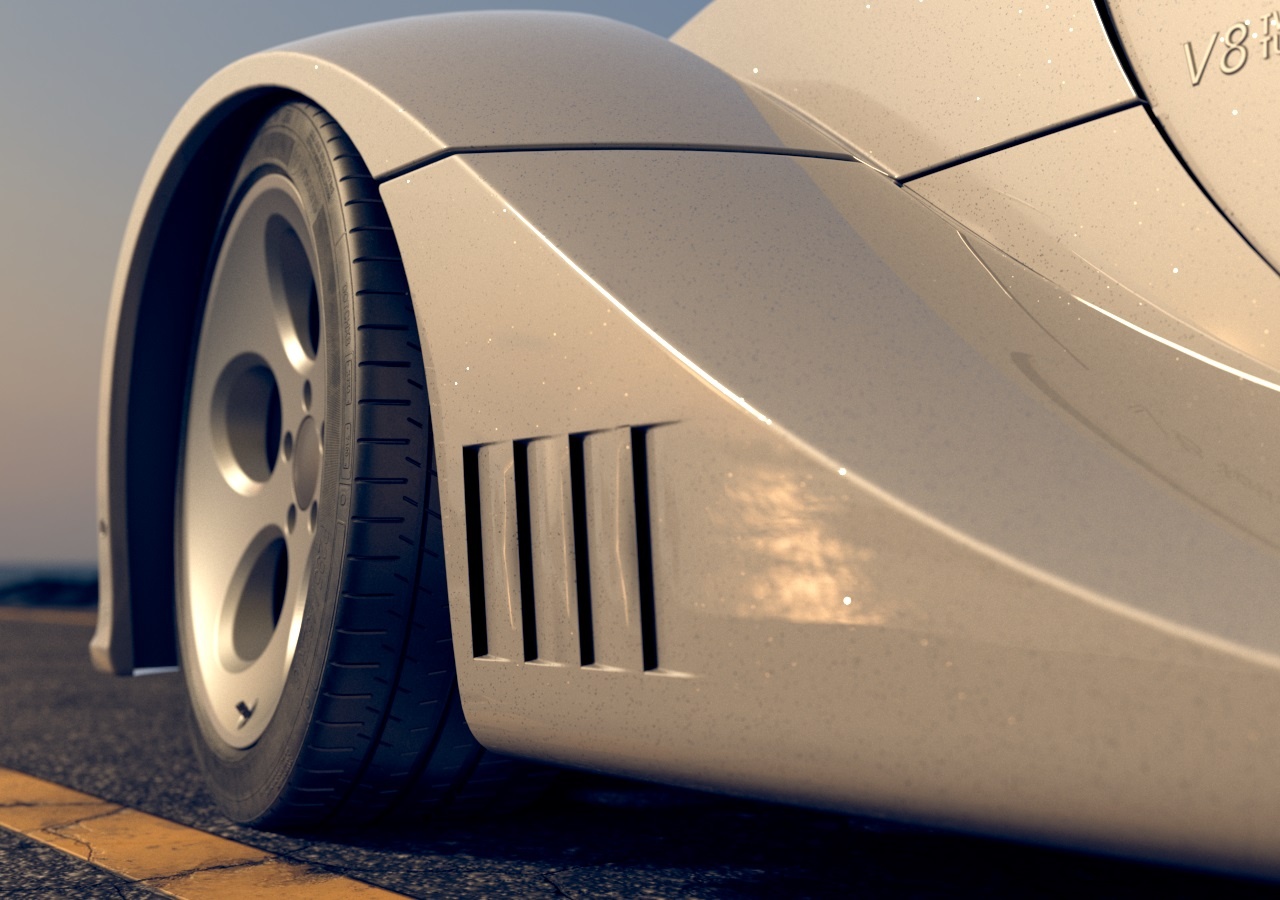This page offers information about the V-Ray BRDFCarPaint2 material node.
Overview
The V-Ray BRDFCarPaint2 material node simulates a metallic car paint. It is a complex material with three layers: a base diffuse layer, a flake layer, and clear coat layer. The material allows the adjustment of each of these layers separately.
The new V-Ray BRDFCarPaint2's advantage is that it uses GGX BRDF type and offers base glossiness tail falloff option.
Base Tab
Color – Specifies the diffuse color or map for the base layer.
Reflection – Specifies reflectivity value or map for the base layer. The reflection color itself is the same as the Color.
Glossiness – Specifies reflection glossiness value or map for the base layer. Higher values such as the default make the highlights sharper, while lower values make the transition more subtle.
Glossiness Tail – Controls the transition from highlighted areas to non-highlighted areas. Higher values such as the default make the highlight transition sharper and lower values make the glossiness tail more diffuse.
Trace Base Reflections – When disabled, the base layer only produces specular highlights, but no (glossy) reflections.
Bump Type – Specify whether a bump map or a normal map effect is added to the base material.
Bump Map
Normal (Tangent)
Normal (Object)
Normal (Camera)
Normal (World)
From Bump Output
Explicit Normal
Bump Strength – Specifies a multiplier for the bump/normal effect.
Coat Tab
Amount – Specifies the thickness amount of the coat layer. A value of 0 does not add a coat layer, while higher values blend the coat gradually.
Color – Specifies the color or map of the coat layer.
Glossiness – Specifies the glossiness value or map of the coat reflections.
IOR – Specifies the Index of Refraction for the coat layer.
Bump Type – Specify whether a bump map or a normal map effect is added to the coat material.
Bump Map
Normal (Tangent)
Normal (Object)
Normal (Camera)
Normal (World)
From Bump Output
Explicit Normal
Bump Strength – Specifies a multiplier for the bump/normal effect.
Trace Coat Reflections – When disabled, the clear coat only produces specular highlights, but no actual reflections.
Flakes
Color – Specifies the color or map of the metal flakes.
Orientation – Specifies the orientation value or map of the metal flakes. The orientation of the flakes is relative to the surface normal. When set to 0.0, all flakes are perfectly aligned with the surface. When set to 1.0, the flakes are rotated completely randomly with respect to the normal. Values above 0.5 are not recommended as they can produce artifacts. See the Flake Orientation example below.
Flake Orientation Tail – Controls the transition from highlighted areas to non-highlighted areas.
Density – Specifies the density (number of flakes) for a certain area. Lower values produce less flakes and higher values produce more flakes. Set this to 0.0 to produce a material without flakes. See the Density example below.
Scale – Scales the entire flake structure. See the Scale example below.
Size – Specifies the size of the flakes relative to the distance between them. Higher values produce bigger flakes and lower values produce smaller flakes. See the Size example below.
Map Size – Internally the material creates several bitmaps to store the generated flakes. This parameter determines the size of the bitmaps. Lower values reduce RAM usage, but may produce noticeable tiling in the flake structure. Higher values require more RAM, but tiling is reduced.
Seed – The random seed for the flakes. Changing this produces different flake patterns.
Flake Glossiness – Specifies the reflection glossiness value of the flakes.
Options
Double-Sided – When enabled, it makes the material double-sided.
Trace Reflections for All Layers – Global switch to toggle reflections for all layers.
Trace Depth – Specifies the number of times a ray can be reflected.
Cutoff – Specifies the cutoff threshold for the reflections of the different layers.
Use Environment Override – Enables the use of Environment override textures.
Environment Override – Specifies an Environment override texture.
Environment Priority – Specifies the Environment override priority when several materials override it along a ray path.
Example: Flake Orientation
This example demonstrates the effect of the Orientation parameter. Note how lower values produce flakes more aligned with the surface normal, so that light is reflected more uniformly. Higher values produce more random flakes leading to more variation in the flake illumination. Here, Scale is set to 0.3, Size to 0.5, Density to 3 and Flake Orientation Tail is set to 2.
Example: Flake Density
This example demonstrates the effect of the Density parameter. Note how larger values produce more flakes, but do not change the flake size. Here, flake Scale is set to 0.3 and flake Size is set to 0.4.
Example: Scale
This example demonstrates the effect of the Scale parameter. Note how lower values scale the entire flake structure. Here, Density is set to 6 and Size is set to 0.2.
Example: Size
This example demonstrates the effect of the Size parameter. Note how larger values make the individual flakes larger, but do not change their count. Scale is set to 1, the default value. Density is set to 3.0, Orientation is set to 0.




























